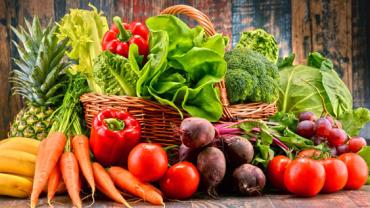
With summer upon us and farmers’ markets in full swing offering an array of beautiful produce, let’s explore a delicious way to increase absorption of nutrients from vegetables and fruit. It might not come as much of a surprise to nutrition professionals, but laypeople can take heart that certain nutrients in these foods are better absorbed when consumed along with fat. This means no more guilt when using oil or full-fat salad dressings!
There may be a reason steamed carrots or broccoli taste better with a little butter melted on them, or why, for many people, a salad with ranch or blue cheese dressing, or a nice vinaigrette, is more appealing than a pile of naked lettuce leaves. A study in the American Journal of Clinical Nutrition (AJCN) found that when subjects consumed a salad with fat-free dressing, there was “essentially no absorption of carotenoids” (specifically alpha- and beta-carotene, and lycopene) compared to a higher level absorbed when the salad was consumed with a reduced-fat canola oil-based dressing. The highest amount was absorbed when full-fat dressing was used. So, rather than feeling guilty about adding calories to a salad, people should take comfort in knowing they’re probably better off, nutritionally speaking, enjoying it with fat.
A more recent study also published in AJCN had similar findings: absorption of alpha- and beta-carotene, lycopene, lutein, and alpha- and gamma-tocopherol were substantially higher when a salad was consumed with 32 g of a soybean oil-based dressing compared to lower amount, in a linear fashion: the more oil used, the greater the nutrient absorption. Soybean oil, being a highly processed industrial oil heavy in omega-6 fatty acids, might not be the best choice, but there’s always olive oil, or avocado or macadamia oils, which are richer in monounsaturated fatty acids. (See here for a primer on the different types of dietary fatty acids.)
Oils and dressings aren’t the only way to increase absorption of these nutrients. It seems that fat in general is the main factor. This was demonstrated in a study looking at the effect of co-ingestion of eggs with a raw vegetable salad. Subjects who consumed a salad with 3 g canola oil (not enough to make much difference in nutrient absorption, according to the studies cited previously) with or without eggs (either 1.5 eggs or 3 eggs) had significantly greater carotenoid content in their triacylglycerol-rich lipoproteins (TRL) from the high-egg meal compared to the low-egg meal and the meal without eggs. Since egg yolks contain lutein and zeaxanthin and egg consumption would increase blood levels of these regardless of the foods co-ingested with them, researchers also tested for levels of alpha- and beta-carotene, as well as lycopene. Here again, the raw vegetable salad consumed with 3 eggs resulted in greater TRL concentrations of nutrients than the vegetables consumed with fewer eggs or no eggs. The total mean carotenoid area under the curve (AUC) in TRL for the high-egg meal was 125.7 compared to 44.8 for the low-egg meal and just 14.9 for the salad with no eggs. The TRL AUC for carotenoids not present in eggs—meaning that they came solely from the vegetables—increased 3–8-fold for the high-egg meal compared to the no-egg meal. Sounds like including hard boiled eggs on a cobb salad is a great way to ensure absorption of nutrients from the vegetables, and using egg yolk to emulsify a classic caesar dressing has culinary and nutritional science behind it.
The old adage that “you are what you eat” isn’t exactly accurate. It’s a good placed to start in terms of getting people to focus on whole, unprocessed, nutrient-rich foods, but it’s more illustrative to say “you are what you digest and absorb.” After all, what’s the point of patients going out of their way to consume certain foods if they’re not getting the full benefit of the nutrients those foods contain? As one paper stated, “The effect of any dietary compound is influenced by the active bioavailable dose rather than the dose ingested.” Nutrient assimilation may have less to do with a mass action effect than with efficiency of absorption. Buying and preparing whole foods is the foundation of a nutritious diet, but those looking to maximize nutritional “bang for their buck” should be aware of certain issues that affect absorption of vitamins and minerals—and enjoying foods with a bit of fat is certainly a tasty way to do it.